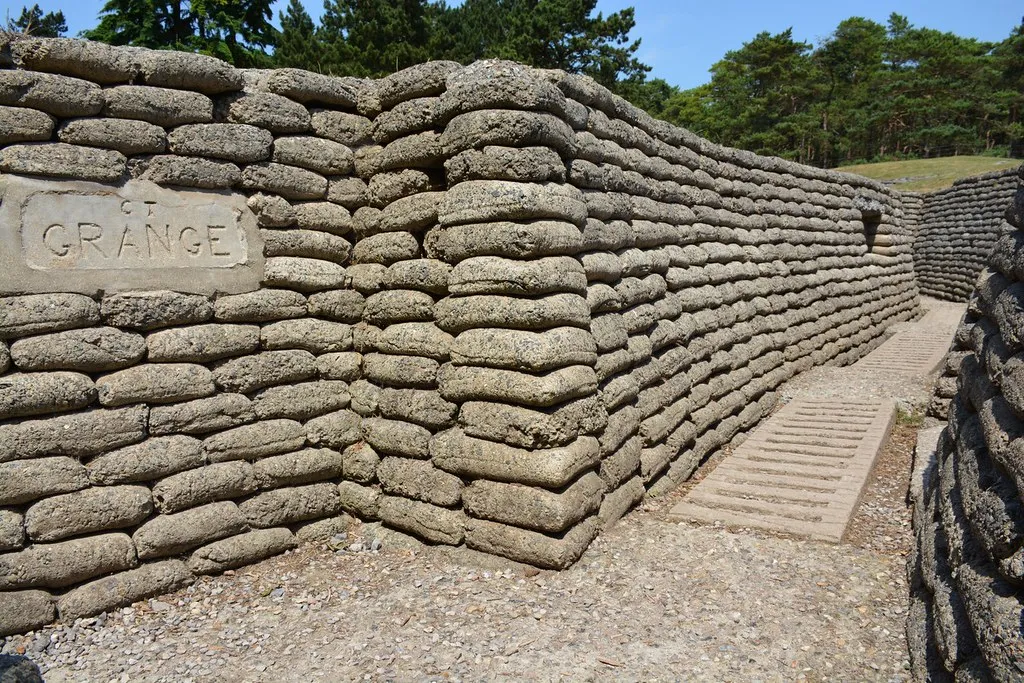Explore These World War I Trenches and Tunnels in France and Belgium
These four sites give visitors a glimpse into the trench warfare tactics soldiers experienced during the Great War
:focal(585x471:586x472)/https://tf-cmsv2-smithsonianmag-media.s3.amazonaws.com/filer/67/3d/673d376c-fb1e-4c24-8266-c59ef5fc95dc/istock-533838141.jpg)
For troops serving on the front lines during World War I, trench warfare was common practice. The use of machine guns and rapid-fire field artillery pieces forced soldiers on both sides, the Allies and the Central Powers, to bore intricate trench systems into the ground. These trenches served as protection against enemy fire and allowed soldiers to fire back without being fully exposed. Tunnels, on the other hand, were used to surreptitiously place explosives beneath unsuspecting enemy soldiers and move supplies between different parts of a battleground. In one known instance, a tunnel was used as an underground hospital.
While overgrowth and erosion have largely overtaken many battlegrounds in the 100 years since the Treaty of Versailles was signed, officially ending the war between Germany and the Allies, archaeologists, historians and even civilians have uncovered the remnants of these protective hideaways throughout Europe. These sites are important glimpses, even today, into battles that took place during the Great War.
Here are four tunnels and trenches visitors can see firsthand:
Canadian Memorial, Vimy, France

One of the first things visitors notice at this memorial site in northern France, about 125 miles north of Paris, is the massive limestone monument that commemorates the thousands of Canadian soldiers who went missing or were presumed dead during the First World War. The memorial sits on the site of the Battle of Vimy Ridge overlooking the restored remnants of an elaborate system of brick-lined trenches and tunnels burrowed in the surrounding green hills.
In preparation for the battle, the Canadian Armed Forces worked with several British tunneling companies to create an intricate underground network of tunnels, some nearly a kilometer in length to protect soldiers and to facilitate and disguise the movement of troops and supplies. This was particularly important as the Germans held the higher ground in the region and could easily spot activity on the surface. Some tunnels were outfitted with running water and lighting systems. Others were used to covertly position explosives beneath German fortifications.
On the morning of Easter Sunday, April 9, 1917, during a sleet storm, the Canadian Armed Forces attacked the German Sixth Army. Waves of Canadian troops poured over the trench walls following close behind an artillery attack designed to give the Canadians time to reach the German positions before the Sixth Army could recover from the barrage. Despite heavy losses, the Canadians succeeded in driving the Germans back.
Today, tour groups can explore both the tunnels and trenches with guides, or virtually via Google Canada.
Wellington Quarry, Arras, France
/https://tf-cmsv2-smithsonianmag-media.s3.amazonaws.com/filer/10/9b/109b5136-8e11-403c-94ba-75c9884c0e23/5088907181_a3fbb80f30_b.jpg)
The tunnels associated with the Wellington Quarry, or la Carrière Wellington, located 110 miles north of Paris, were so elaborate that they contained a working hospital for the British Army and Allied Powers fully equipped with 700 beds and operating theaters. Not only that, but workers from the New Zealand Tunneling Company—tapped to complete the massive project—built the labyrinth of passageways so that they interlinked with preexisting tunnels dating back to the Middle Ages. (The name Wellington is a nod to New Zealand's capital city.) Today, the Carrière Wellington Museum resides underground, and tours include an elevator ride 70 feet below the surface, a description of the 1917 Battle of Arras that happened here between the British Empire and German Empire, and a glimpse at soldiers’ subterranean lives by visiting their sleeping quarters and the hospital for wounded soldiers.
Sanctuary Wood, Ypres, Belgium
/https://tf-cmsv2-smithsonianmag-media.s3.amazonaws.com/filer/40/4f/404f36f7-f524-4cf4-8451-d420048f9554/istock-174939198.jpg)
Once the dust settled after the final battle of World War I and citizens received the all clear, one farmer by the name of Schier returned to reclaim his property and discovered a maze of trenches bored into his land in western Belgium. Rather than replant his crops, he decided to keep the land as it was to preserve the memory of the Great War and those who lost their lives in battle. In the century since, the property remains in the hands of the same family, the Schiers, who maintain it and have kept it largely the way it appeared when their late relative discovered it. Today, Sanctuary Wood serves as a museum filled with artifacts discovered onsite, including weapons, ammunition, gravesites, soldiers’ personal belongings and photos. But arguably the main feature is the series of zigzagging, corrugated metal-lined trenches that stand as a reminder of where the British front line once resided and where hundreds of men lost their lives.
Beaumont-Hamel Newfoundland Memorial, Beaumont-Hamel, France
/https://tf-cmsv2-smithsonianmag-media.s3.amazonaws.com/filer/d7/3c/d73c1961-0f97-4ba8-bb9b-e144c9f5370d/beaumont-hamel_tranchees_3.jpg)
Among the trenches that make up this network constructed in a pocket of northern France, located about 100 miles southwest of Belgium, are some of the most shallow built during the war. In the years since, they have been taken back by nature. The undulating hills and valleys appear, on first glance, to be a mere quirk of the landscape, but in reality they served as protection for the Allied Powers. Today, the 74-acre site is home to a memorial—a bronze caribou atop a granite pyramid—commemorating soldiers of the Canadian Armed Forces, in particular those from Newfoundland who bravely served their country.
Planning Your Next Trip?
Explore great travel deals
Smithsonian magazine participates in affiliate link advertising programs. If you purchase an item through these links, we receive a commission.